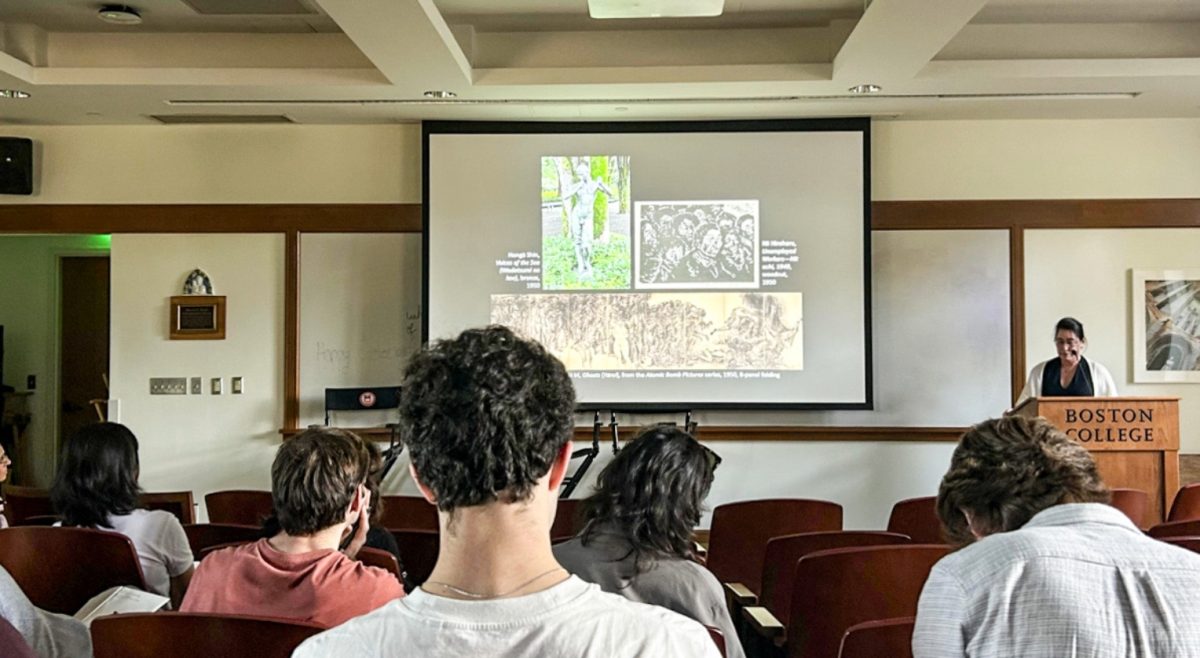The Bonn Theatre, Robsham’s amorphous studio space, underwent a radical transformation for the staging of Ntozake Shange’s choreopoem For Colored Girls Who Have Considered Suicide When the Rainbow is Enuf last week. Ben Wilson, scenic and lighting designer and A&S ’14, transformed the space into a cabaret-style performance venue, loosely inspired by Bacchanal, the California women’s bar where the experimental play was first staged in 1975. The ceiling was decked in string lights, and the walls covered in Black-American folk art. The audience was brought onto the set, seated in the performance area as crowds would have been at the ’75 production.
Related: ‘For Colored Girls’: The Story Beyond The Script
Bringing the production in a very visible way back to this decade of racial unrest functioned as far more than just a stylistic choice. Shange’s work candidly addresses issues of race in a manner atypical of modern theatre, addressing themes left undiscussed in the dialogue on race encouraged at today’s universities. Boston College, four decades ago a place of wild social protest, has since grown docile. Conversations on race have gradually narrowed into little more than a call to inclusivity since the race riots of the 1960s and 1970s turned the nation on its head.
The BC theatre department’s production of For Colored Girls was decidedly not inclusive-the show’s all-female, all-black cast was the first in the University’s history. It was a unique opportunity for the show’s eight-woman cast to speak forwardly about issues historically relevant to the black community. Directed by John Houchin, an associate professor within the theatre department, in conjunction with guest artist Robbie McCauley, a member of the show’s Broadway cast, For ColoredGirls was one of the bravest productions ever staged at BC, a forthcoming vignette of racial identity. Looking beyond the social implications of the production, however,For Colored Girls was just great theatre.
The eight actors featured in the show were confronted with one of the most daunting scripts in popular theatre. A series of 20 poems, Shange’s words are at once very direct and topical, while only being abstractly held together. The chemistry of this small group of performers was essential to the show’s execution. While most of the poems were read as monologues, the response of the other women was critical to their execution. Following the more gritty monologues featured in the show, the performers would comfort each other and respond to each other’s suffering.
Gallery: Meet The Cast Of ‘For Colored Girls’
Ashlie Pruitt, A&S ’15, delivered some of the most devastating of the show’s material in a piece detailing an abortion. Tears streamed down Pruitt’s face as she took up the persona of Lady in Blue-she was spitting and shaking on the stage. “Abortion Cycle #1” outlines the dehumanizing aspects of the abortion process: Blue is violated, ignored, as she cries out for the abortionist to “Get those eyes offa me / Get them steel rods outta me.” This part of the show particularly was reminiscent of a scene from Eve Ensler’s Vagina Monologues-also staged at BC this semester-detailing the genital mutilation of a Bosnian woman. The performance of these graphic, heavy accounts is part of a larger effort by feminist playwrights, like Shange and Ensler, to reclaim woman’s agency over her own anatomy.
Beyond this, however, the comparison between For Colored Girls and The Vagina Monologues begins to break down. The Vagina Monologues is now performed as part of the V-Day movement-a nonprofit raising money to fight violence toward women-and productions of it had become an annual occurrence at schools like BC. For Colored Girls, also an experimental work addressing a cultural identity, plays out in a far less pointed manner. Its production is more of an open-ended undertaking. BC’s production was far more than a series of monologues, integrating elements of dance and ending with a gospel-style ensemble vocal performance while repeating the lines, “I found God in myself / And I loved her.”
The audience, too, became a particularly important part of the performance. Toluwase Oladapo, A&S ’16, singled out specific male members of the audience during her performance of “Somebody Almost Walked Off Wid Alla My Stuff,” a poem telling the story of a woman who nearly gives up her identity for a man.
The show reaches an emotional climax with Lady in Red’s “A Nite With Beau Willie Brown,” performed by Raven Tillman, LSOE ’14. By the end of the poem, Tillman was shouting in full voice, telling the story of a woman abused by the father of her two children, insisting she marry him, and eventually, killing his own kids.
For Colored Girls has painful and tragic elements, but ultimately, its narrative highlights the brazen self-love required for its characters to carry on through these hardships. The extraordinary cast of For Colored Girls brought Shange’s work to the BC community with a level of authenticity and thoughtfulness uncommon to University productions. The 90-minute show covered some incredibly heavy, often uncomfortable material, but there wasn’t a false note in the production-they kept true to the source and shared these stories fiercely.












